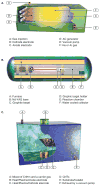Carbon nanotubes part I: preparation of a novel and versatile drug-delivery vehicle
- PMID: 25601356
- PMCID: PMC4475469
- DOI: 10.1517/17425247.2015.1003806
Carbon nanotubes part I: preparation of a novel and versatile drug-delivery vehicle
Abstract
Introduction: It is 23 years since carbon allotrope known as carbon nanotubes (CNT) was discovered by Iijima, who described them as "rolled graphite sheets inserted into each other". Since then, CNTs have been studied in nanoelectronic devices. However, CNTs also possess the versatility to act as drug- and gene-delivery vehicles.
Areas covered: This review covers the synthesis, purification and functionalization of CNTs. Arc discharge, laser ablation and chemical vapor deposition are the principle synthesis methods. Non-covalent functionalization relies on attachment of biomolecules by coating the CNT with surfactants, synthetic polymers and biopolymers. Covalent functionalization often involves the initial introduction of carboxylic acids or amine groups, diazonium addition, 1,3-dipolar cycloaddition or reductive alkylation. The aim is to produce functional groups to attach the active cargo.
Expert opinion: In this review, the feasibility of CNT being used as a drug-delivery vehicle is explored. The molecular composition of CNT is extremely hydrophobic and highly aggregation-prone. Therefore, most of the efforts towards drug delivery has centered on chemical functionalization, which is usually divided in two categories; non-covalent and covalent. The biomedical applications of CNT are growing apace, and new drug-delivery technologies play a major role in these efforts.
Keywords: addition reaction; carbon nanotubes; functional group; functionalization; purification; synthesis.
Conflict of interest statement
This work was supported by NIH grant R01A1050875. The authors have no other relevant affiliations or financial involvement with any organization or entity with a financial interest in or financial conflict with the subject matter or materials discussed in the manuscript apart from those disclosed.
Figures





References
-
- Farokhzad OC, Langer R. Impact of nanotechnology on drug delivery. ACS Nano. 2009;3(1):16–20. - PubMed
-
- Jahromi MAM, Karimi M, Azadmanesh K, et al. The effect of chitosan-tripolyphosphate nanoparticles on maturation and function of dendritic cells. Comp Clin Pathol. 2014;23:1421–7.
Publication types
MeSH terms
Substances
Grants and funding
LinkOut - more resources
Full Text Sources
Other Literature Sources
Medical
